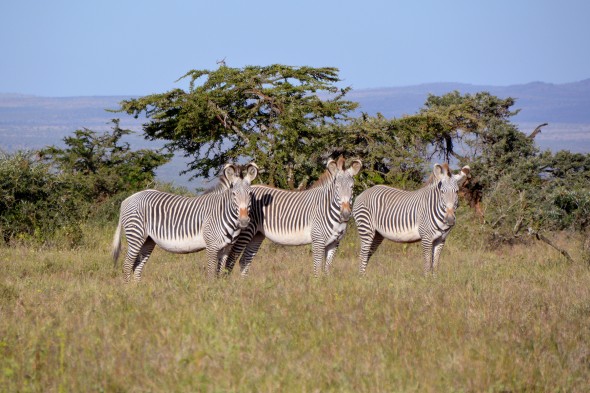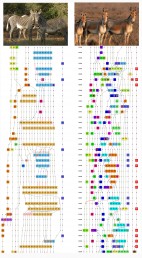Social-network analysis reveals animal bonding behaviors

To study the communities formed by two types of social animals – Grevy’s zebra and the onager – a research team led by UIC computational ecologist Tanya Berger-Wolf developed a dynamic social-network analysis tool. Photo: Tanya Berger-Wolf (select image to download)

Dynamic communities of the two equids show a cohesive structure of Grevy’s zebra versus very transient one for onagers. Image credit: Tanya Berger-Wolf , Chayant Tanipathananandh, Daniel Ruberstein, Sive Sundaresan. Click on image to download.
Communities are defined by flux: friendships that form and break, loyalties that shift, and visitors passing through. But these dynamic interactions aren’t represented in static maps of social networks. Snapshot diagrams – with lines drawn between individuals to show the ties that connect them based on data collected over time – can’t tell the whole story.
Zoologists are similarly hampered when trying to analyze the community organization of social animals. The bonding behaviors of related species may seem similar, even though the environments that shaped the animals’ group-behavior are quite different.
Two such closely related species are the endangered Grevy’s zebra of Africa—the largest surviving wild equid — and the onager, a wild ass of Asia. A new, dynamic social-network analysis tool has revealed that the two species actually have radically different social behaviors and community structures.
The study was published online in PLOS ONE.
University of Illinois at Chicago computational ecologist Tanya Berger-Wolf led the multi-disciplinary team that created CommDy, a dynamic network computational framework, to better understand group behavior and community.
Both Grevy’s zebra and the Asian wild asses form what are known as fission/fusion communities, said Berger-Wolf, who is associate professor of computer science at UIC. In fission/fusion communities, individuals meet and spend time with others in different groups at different times.
The two animals’ communities look similar, using a traditionally static social-network analysis. But the zebras are few in number, limited in range, and menaced by large predators such as lions. They often lack access to water. Onagers, in contrast, are relatively abundant and widespread, with no major predators and reliable access to water. One would expect the two species to have evolved very different social structures to cope with their different circumstances.
To observe the daily interactions within each of the two animal communities, three study co-authors from the Mpala Research Centre in Kenya–ecologists Daniel Rubenstein of Princeton University, Siva Sundaresan of the Jackson Hole Conservation Alliance in Wyoming, and Ilya Fischoff of the University Corporation for Atmospheric Research in Washington, D.C. — drove repeatedly along the same route through the animals’ territory and recorded the size, duration and membership of different groups. The software allowed the researchers to contextualize the observed interactions.
“We’re looking for the latent community structure — loyalties, changes in affiliation, visiting with other groups — and the social cost of change,” Berger-Wolf said. Some interactions may have a negative impact for an individual, she said, by increasing stress or inviting harassment. Other social contacts may be positive, by increasing status or access to resources.
“The dynamic communities that resulted from that computational analysis were actually strikingly different,” Berger-Wolf said. The Grevy’s zebra lived in large, stable groups, with loyalty rewarded and visiting with other groups discouraged. Onagers formed smaller, less cohesive groups, with individuals able to change circles with little social cost.
Berger-Wolf said these newly revealed differences make sense, given the different adaptation each species needed to survive. And for the first time, scientists were able to quantify the differences, using the computational tool.
Facing a constant threat from a predator, the Grevy’s zebra finds strength in numbers, forming large groups of loyal individuals. The large, stable herd is also able to share found resources, like water. The onager, in contrast, can form smaller, more transient groups, being less dependent on the herd for protection or finding scarce resources.
“Dynamic community analysis can be an important tool for testing ideas about the selective ecological and evolutionary forces that generate behaviors, revealing their adaptive value and significance,” Berger-Wolf said.
Chayant Tantipathananandh of Google Inc. in Mountain View, California, was co-author on the paper.
This work was supported in part by Princeton University, McMaster University, the Smithsonian Institution, the Denver Zoological Foundation, the Wildlife Conservation Society, UIC, Microsoft award 14936, and the following NSF grants: IBN-0309233, CNS-025214, IOB-9874523, IIS-0705822, IIS-0747369, OCI-1152895 and CNS-1248080.
Categories
Topics
animal behavior, computer analysis, computer science, evolution, nature, social network
